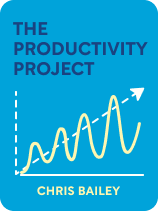
This article is an excerpt from the Shortform book guide to "The Productivity Project" by Chris Bailey. Shortform has the world's best summaries and analyses of books you should be reading.
Like this article? Sign up for a free trial here.
Do you get distracted a lot? How do distractions hinder your performance?
Getting distracted not only wastes your valuable time but also makes it more difficult to resume focus. Attention research has shown that employees focus on a project for 11 minutes before being interrupted, and on average it takes them 25 minutes to refocus.
Here are some tips for managing distractions and preventing them from stealing your focus.
Manage Distractions
Bailey explains that distractions come in two forms—internal and external. Internal distractions originate in your own mind and can take the form of worries and anxiety, emotional reactions, boredom, hunger, or just unconscious impulses or habits, while external distractions exist outside of us and take the form of phone alerts, emails, or especially chatty colleagues.
| Managing Distractions by Seeking Out Flow According to psychologist and Flow author Mihaly Csikszentmihalyi, most people live in an almost-constant state of distraction, either focused on external stimuli or on unpleasant internal feelings and ideas. Flow, or what Bailey might call intentional focus, is a clear sense of purpose that allows you more control over your thoughts and feelings. While it’s possible to experience flow unexpectedly, you’re more likely to enter a flow state by seeking out experiences that facilitate flow. Csikszentmihalyi recommends four flow-producing activities: experiences that generate a new sense of self, experiences that provide the opportunity to achieve a specific goal, experiences that provide an opportunity for growth, or experiences that shift your perception of reality. |
External distractions are more straightforward and easier to control. To manage external distractions, try having designated times when people know you’re focusing and unreachable. Bailey also suggests making the source of external distractions more inconvenient to access. For example, leave your phone in another room, turn off all notifications, or disconnect from the internet entirely if a task allows.
(Shortform note: Indistractable author Nir Eyal clarifies that not all external distractions are bad. For example, you may have alerts on your phone reminding you to drink water or take a break. He recommends identifying which of your external triggers are useful and which are distracting. Any time an external distraction pops up, you can ask yourself, “Does this trigger benefit me?” If it doesn’t benefit you or your work, then you should try to remove or mitigate that distraction.)
Internal distractions are harder to control because they arise from inside us. Internal distractions, like anxiety or boredom, are often at the root of procrastination. If you’re feeling bored or anxious or overwhelmed, it’s easier to turn away from the task at hand to something simpler and more appealing. It’s especially tempting to procrastinate on your most significant tasks because these tasks are often the most challenging, ambiguous, or frustrating. For example, if you’re feeling anxious about a significant task, you’re more likely to pick up your phone to check the latest notification message or scroll a little longer on Instagram.
(Shortform note: Eyal argues that the root of all distraction is internal. He explains people are primarily motivated by freedom from discomfort; therefore, when we feel physical or mental discomfort, we look for ways to escape it. Many of our external distractions are in fact escape mechanisms from the internal trigger of mental discomfort.)
When you notice internal distractions leading to procrastination, Bailey recommends asking yourself why and then finding a way to counteract whatever is triggering your procrastination. For example, if a task is boring, go to your favorite bar to get it done. Or if a task is unstructured, create a detailed plan that you’ll follow. And, when all else fails, you can have a go-to procrastination list of necessary insignificant tasks. Then, you can make progress on some of your less important work until you’re ready to focus again.
(Shortform note: Eyal recommends a more in-depth reflection exercise when you notice yourself procrastinating. First, he recommends identifying the trigger. Ask yourself: “What discomfort or feeling triggered my procrastination?” Next, note the trigger. He recommends a “distraction tracker” where you write down your internal trigger, the time of day, the location, who you were with, and the distracting action you took to escape that feeling. He then recommends spending time examining the feeling you had, and he encourages you to spend as much time as necessary to really understand the root cause of your procrastination.)
Find the Balance
While learning how to focus is important, Bailey explains that it’s also important to give your brain a break. Research has shown that the brain fluctuates between two modes—a relaxed mode that’s more introspective and intuitive, and a focused mode that’s deliberate and analytical. Our relaxed brain is good at ideation and creative problem-solving, while our focused brain is great at management and analytical work. Both are important, so the key is to find a balance between the two.
(Shortform note: In A Mind for Numbers, Barbara Oakley explains that your brain naturally moves between the two modes. While Bailey is focused on the different roles of each mode, Oakley focuses on how these two modes can work together. She explains that challenging problem-solving requires both modes to exchange information. So when tackling a difficult problem, she recommends starting by focusing on the problem, and then deliberately diverting your attention elsewhere so that your brain can switch into relaxed mode. She suggests alternating between both modes until you’re able to solve the problem.)
Bailey suggests being intentional about creating time for your mind to drift. Some strategies to flip your brain into relaxed mode include taking a shower, leaving your phone at home, going for a walk, listening to music, or playing sports. (Shortform note: Being bored is also an effective tool to help your mind wander. When you’re doing something uninteresting or monotonous, your mind naturally starts to drift away from the task toward more interesting and unrelated topics. If you struggle with boredom or doing nothing, try visiting the website Do Nothing For 2 Minutes for a short practice session.)

———End of Preview———
Like what you just read? Read the rest of the world's best book summary and analysis of Chris Bailey's "The Productivity Project" at Shortform.
Here's what you'll find in our full The Productivity Project summary:
- A how-to book for anyone who wants to become more productive
- Why productivity isn't about doing a lot, but doing what matters
- How to hone your focus and monotask better






